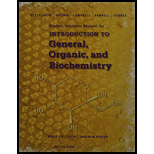
Concept explainers
(a)
Interpretation:
Structural formula of the given carbon skeleton is to be completed by adding hydrogen atoms to fulfil the valency of carbon.
Concept Introduction:
Valency of carbon is four. In organic compounds carbon make bonds with different atoms and remaining valency of carbon is always fulfilled by hydrogen atoms.
(b)
Interpretation:
Structural formula of the given carbon skeleton is to be completed by adding hydrogen atoms to fulfil the valency of carbon.
Concept Introduction:
Valency of carbon is four. In organic compounds carbon make bonds with different atoms and remaining valency of carbon is always fulfilled by hydrogen atoms.
(c)
Interpretation:
Structural formula of the given carbon skeleton is to be completed by adding hydrogen atoms to fulfil the valency of carbon.
Concept Introduction:
Valency of carbon is four. In organic compounds carbon make bonds with different atoms and remaining valency of carbon is always fulfilled by hydrogen atoms.
(d)
Interpretation:
Structural formula of the given carbon skeleton is to be completed by adding hydrogen atoms to fulfil the valency of carbon.
Concept Introduction:
Valency of carbon is four. In organic compounds carbon make bonds with different atoms and remaining valency of carbon is always fulfilled by hydrogen atoms.
(e)
Interpretation:
Structural formula of the given carbon skeleton is to be completed by adding hydrogen atoms to fulfil the valency of carbon.
Concept Introduction:
Valency of carbon is four. In organic compounds carbon make bonds with different atoms and remaining valency of carbon is always fulfilled by hydrogen atoms.
(f)
Interpretation:
Structural formula of the given carbon skeleton is to be completed by adding hydrogen atoms to fulfil the valency of carbon.
Concept Introduction:
Valency of carbon is four. In organic compounds carbon make bonds with different atoms and remaining valency of carbon is always fulfilled by hydrogen atoms.
(g)
Interpretation:
Structural formula of the given carbon skeleton is to be completed by adding hydrogen atoms to fulfil the valency of carbon.
Concept Introduction:
Valency of carbon is four. In organic compounds carbon make bonds with different atoms and remaining valency of carbon is always fulfilled by hydrogen atoms.
(h)
Interpretation:
Structural formula of the given carbon skeleton is to be completed by adding hydrogen atoms to fulfil the valency of carbon.
Concept Introduction:
Valency of carbon is four. In organic compounds carbon make bonds with different atoms and remaining valency of carbon is always fulfilled by hydrogen atoms.
(i)
Interpretation:
Structural formula of the given carbon skeleton is to be completed by adding hydrogen atoms to fulfil the valency of carbon.
Concept Introduction:
Valency of carbon is four. In organic compounds carbon make bonds with different atoms and remaining valency of carbon is always fulfilled by hydrogen atoms.
Trending nowThis is a popular solution!

Chapter 10 Solutions
Student Solutions Manual for Bettelheim/Brown/Campbell/Farrell/Torres' Introduction to General, Organic and Biochemistry, 11th
- What is the final product when D-galactose reacts with hydroxylamine?arrow_forwardIndicate the formula of the product obtained by reacting methyl 5-chloro-5-oxopentanoate with 1 mole of 4-penten-1-ylmagnesium bromide.arrow_forwardIn the two chair conformations of glucose, the most stable is the one with all the OH groups in the equatorial position. Is this correct?arrow_forward
- please help me with my homeworkarrow_forwardhelparrow_forwardThe temperature on a sample of pure X held at 1.25 atm and -54. °C is increased until the sample boils. The temperature is then held constant and the pressure is decreased by 0.42 atm. On the phase diagram below draw a path that shows this set of changes. pressure (atm) 2 0 0 200 400 temperature (K) Xarrow_forward
- QUESTION: Answer Question 5: 'Calculating standard error of regression' STEP 1 by filling in all the empty green boxes *The values are all provided in the photo attached*arrow_forwardpressure (atm) 3 The pressure on a sample of pure X held at 47. °C and 0.88 atm is increased until the sample condenses. The pressure is then held constant and the temperature is decreased by 82. °C. On the phase diagram below draw a path that shows this set of changes. 0 0 200 temperature (K) 400 аarrow_forwarder your payment details | bar xb Home | bartleby x + aleksogi/x/isl.exe/1o u-lgNskr7j8P3jH-1Qs_pBanHhviTCeeBZbufuBYT0Hz7m7D3ZcW81NC1d8Kzb4srFik1OUFhKMUXzhGpw7k1 O States of Matter Sketching a described thermodynamic change on a phase diagram 0/5 The pressure on a sample of pure X held at 47. °C and 0.88 atm is increased until the sample condenses. The pressure is then held constant and the temperature is decreased by 82. °C. On the phase diagram below draw a path that shows this set of changes. pressure (atm) 1 3- 0- 0 200 Explanation Check temperature (K) 400 X Q Search L G 2025 McGraw Hill LLC. All Rights Reserved Terms of Use Privacy Cearrow_forward
 Chemistry: The Molecular ScienceChemistryISBN:9781285199047Author:John W. Moore, Conrad L. StanitskiPublisher:Cengage Learning
Chemistry: The Molecular ScienceChemistryISBN:9781285199047Author:John W. Moore, Conrad L. StanitskiPublisher:Cengage Learning Living By Chemistry: First Edition TextbookChemistryISBN:9781559539418Author:Angelica StacyPublisher:MAC HIGHER
Living By Chemistry: First Edition TextbookChemistryISBN:9781559539418Author:Angelica StacyPublisher:MAC HIGHER Organic And Biological ChemistryChemistryISBN:9781305081079Author:STOKER, H. Stephen (howard Stephen)Publisher:Cengage Learning,
Organic And Biological ChemistryChemistryISBN:9781305081079Author:STOKER, H. Stephen (howard Stephen)Publisher:Cengage Learning, General, Organic, and Biological ChemistryChemistryISBN:9781285853918Author:H. Stephen StokerPublisher:Cengage Learning
General, Organic, and Biological ChemistryChemistryISBN:9781285853918Author:H. Stephen StokerPublisher:Cengage Learning Introductory Chemistry: A FoundationChemistryISBN:9781337399425Author:Steven S. Zumdahl, Donald J. DeCostePublisher:Cengage Learning
Introductory Chemistry: A FoundationChemistryISBN:9781337399425Author:Steven S. Zumdahl, Donald J. DeCostePublisher:Cengage Learning General Chemistry - Standalone book (MindTap Cour...ChemistryISBN:9781305580343Author:Steven D. Gammon, Ebbing, Darrell Ebbing, Steven D., Darrell; Gammon, Darrell Ebbing; Steven D. Gammon, Darrell D.; Gammon, Ebbing; Steven D. Gammon; DarrellPublisher:Cengage Learning
General Chemistry - Standalone book (MindTap Cour...ChemistryISBN:9781305580343Author:Steven D. Gammon, Ebbing, Darrell Ebbing, Steven D., Darrell; Gammon, Darrell Ebbing; Steven D. Gammon, Darrell D.; Gammon, Ebbing; Steven D. Gammon; DarrellPublisher:Cengage Learning





